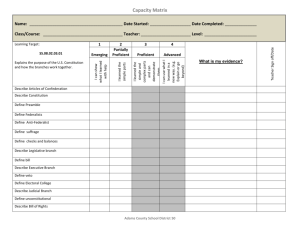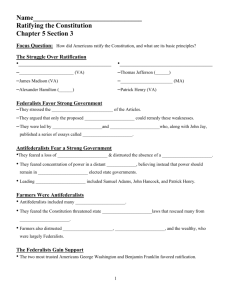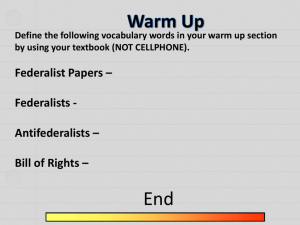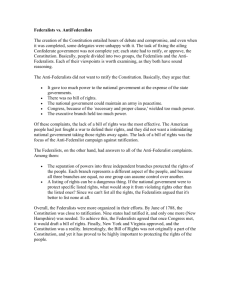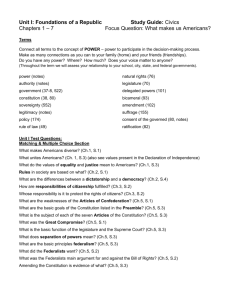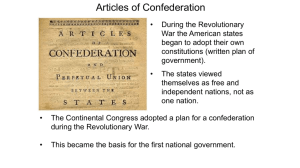8.3 Ratification and the bill of rights
advertisement
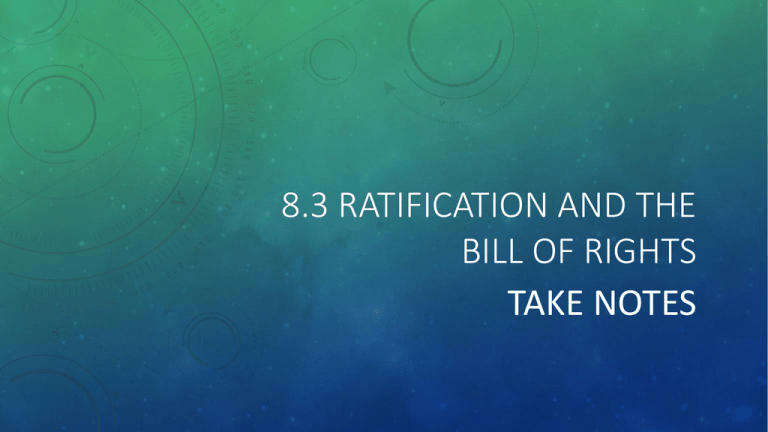
8.3 RATIFICATION AND THE BILL OF RIGHTS TAKE NOTES 8.3 RATIFICATION AND THE BILL OF RIGHTS Before we learned: • The Constitution created a new, stronger government that replaced the Confederation. Now we will learn: • American liberties are protected by the U.S. Constitution and a Bill of Rights. VOCABULARY • Antifederalists- people who opposed ratification of the Constitution • Federalism- system of government in which power is shared between the national (or federal) government and the states • Federalists- people who supported ratification of the Constitution • The Federalist papers- ratification essays published in New York newspapers • Bill of Rights- first ten amendments to the U.S. Constitution • Majority rule- a system in which more than one half of a group holds the power to make decisions binding the entire group • Parliament- Britain’s chief lawmaking body • Enlightenment- 18th century movement that emphasized the use of reason and the scientific method to obtain knowledge FEDERALISTS AND ANTIFEDERALISTS • Key Question: What key issues divided Federalists and Antifederalists? FEDERALISTS • The framers suspected people might be afraid that the Constitution would take too much power away from the states, so they explained that the Constitution was based on federalism. • Federalism- a system of government in which power is shared between the central (or federal) government and the states. • Supporters of the new Constitution called themselves Federalists. FEDERALISTS AND ANTIFEDERALISTS FEDERALISTS • Federalists also promoted their views and answered critics in a series of essays, known as The Federalist papers. • The authors of The Federalist papers were well-known politicians: James Madison, Alexander Hamilton, and John Jay. • The essays first appeared as letters in New York newspapers, calling for ratification on the Constitution. FEDERALISTS AND ANTIFEDERALISTS ANTIFEDERALSITS Antifederalists- people who opposed ratification of the Constitution. ANTIFEDERALIST’s arguments against the Constitution -took too much power from the States -did not guarantee rights for the people -feared a strong president would be declared king -afraid the Senate would become a powerful ruling class -liberties won during the Revolutionary War might be lost FEDERALISTS AND ANTIFEDERALISTS ANTIFEDERALISTS • Antifederalists sent out a pamphlet with the essay, “Observations on the New Constitution, and on the Federal and State Conventions.” • This pamphlet was the work of Mercy Otis Warren, although was falsely attributed to Elbridge Gerry. She was an Antifederalist and a respected historian of the American Revolution. FEDERALISTS VS. ANTIFEDERALISTS ANTIFEDERALISTS • Antifederalists received support from • rural areas, where people feared a strong government that might add to their tax burden. • Large states and those with strong economies, such as New York, which had greater freedom under the Articles of Confederation THE BATTLE FOR RATIFICATION • Key Question: How did the lack of a bill of rights endanger the Constitution? • The Constitution did not guarantee that the government would protect the rights of people or the states. • Some supporters of the Constitution wanted to add a bill of rights, a formal summary of citizens’ rights and freedoms, as a set of amendments to the Constitution. THE BATTLE FOR RATIFICATION • Antifederalists were opposed to the U.S. Constitution and did NOT want it ratified. • Antifederalists wanted written guarantees that the people would have certain freedoms. • Federalists insisted that the Constitution granted only limited powers to the national government so that it could not violate the rights of the states or of the people. • Federalists also argued that the Constitution gave the people power to protect their rights through the election of trustworthy leaders. • Solution? THE BATTLE FOR RATIFICATION • The Federalists met the demands of Antifederalists and promised to add a bill of rights if the states ratified the Constitution. THE BATTLE FOR RATIFICATION State Date Order Votes For Votes Against Delaware December 7, 1787 1 30 0 Pennsylvania December 12, 1787 2 46 23 New Jersey December 18, 1787 3 38 0 Georgia January 2, 1788 4 26 0 Connecticut January 9, 1788 5 128 40 Massachusetts February 6, 1788 6 187 168 Maryland 32 7 63 11 South Carolina May 23, 1788 8 149 73 New Hampshire June 21, 1788 9 57 47 Virginia June 25, 1788 10 89 79 New York July 26, 1788 11 30 27 North Carolina November 21, 1789 12 194 77 Rhode Island May 29, 1790 13 34 • The Constitution was officially ratified on June 21, 1788 when it gained approval by the ninth state. • It was vital to get the support of New York so that the nation would not be split in two geographically. • Virginia also played an important role since it was the largest state at that time. THE BATTLE FOR RATIFICATION • Antifederalists in Virginia warned the South of Northern domination. • Under the Articles of Confederation, each state had one vote and major decisions required the approval of nine of the 13 states. • The Constitution provided for majority rule, a system in which more than one half of a group holds the power to make decisions binding the entire group. • Virginian Antifederalists warned that under this system, the North would be able to make decisions on issues such as trade and slavery that the South would have to follow. THE BATTLE FOR RATIFICATION • After fierce debate, Virginia narrowly ratified the Constitution. • When New York found out that Virginia accepted the Constitution, they then as well ratified the Constitution. (Until then, the Antifederalists outnumbered the Federalists). • It was not until 1789 that North Carolina ratified the Constitution. Rhode Island finally ratified it in 1790. THE BILL OF RIGHTS AND THE CONSTITUTION • James Madison submitted ten amendments, or additions to a document, to the Constitution. • They were placed at the end of the Constitution in a separate section and became known as the Bill of Rights. • • • • • • • • • • THE BILL OF RIGHTS 1. Religions and Political Freedom 2. Right to Bear Arms 3. Quartering Troops 4. Search and Seizure 5. Rights of Accused Persons 6. Rights to a Speedy, Public Trial 7. Trial by Jury in Civil Cases 8. Limits of Fines and Punishments 9. Rights of People 10. Powers of States and People THE BILL OF RIGHTS AND THE CONSTITUTION • Amending the Constitution • The Bill of Rights was the first step in making the Constitution a living document, one that can be amended to reflect the changes in society. • Ways to change the Constitution: First: 2/3 of each house of Congress OR 2/3 of the state legislatures can propose an amendment Second: To make the amendment a law, an amendment needs the approval of ¾ of the states. By this method, the Bill of Rights became the first 10 amendments and since then, 17 more amendments have been added to the Constitution.
